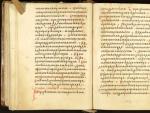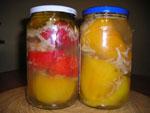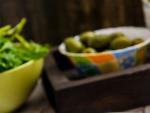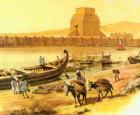Educational practice: “Cooking dishes and side dishes from boiled vegetables” with a presentation of educational and methodological material on the topic. Dishes and side dishes from boiled vegetables Green dip for vegetables
To prepare hot dishes and side dishes, vegetables are boiled in water or steamed. Potatoes and carrots are boiled peeled, beets - in their skins, corn - on the cob without removing the leaves, bean pods - chopped, peas - whole, dried vegetables are pre-soaked.
When cooking, vegetables are placed in boiling water or filled with water (depending on the type of vegetables), salt is added (10 g of salt per 1 liter of water) and cooked with the lid closed. The water should cover the vegetables by 1–2 cm, since when cooking in large amounts of water, large losses of soluble nutrients occur. Beets, carrots and green peas are cooked without salt so that the taste does not deteriorate and the cooking process does not slow down. Green pods of beans, peas, spinach leaves, asparagus and artichokes are boiled in a large amount of rapidly boiling water (3-4 liters per 1 kg of vegetables) and with the lid open to preserve the color. Quick-frozen vegetables are placed in boiling water without defrosting. Canned vegetables are heated together with the broth, and then the broth is drained and used to prepare soups and sauces.
It is better to steam potatoes and carrots: this preserves the nutritional value and taste of the product. For steaming, special steam cooking cabinets or ordinary boilers with a metal grate or wire basket are used.
Boiled potatoes. Peeled potato tubers of the same small size (large potatoes are cut into pieces) are placed in a dish in a layer of no more than 50 cm so that their shape is preserved during cooking, pour hot water so that it covers the potatoes by 1–1.5 cm, add salt, close the dish cover, bring to a boil and cook at low simmer until tender. Then the broth is drained and the potatoes are dried; to do this, cover the dish with a lid and place it on a less hot section of the stove for 2-3 minutes.
Some varieties of potatoes are overcooked and soaked in water, resulting in the taste of the finished dish deteriorating. Therefore, when boiling such potatoes, the water is drained 15 minutes after boiling, the potatoes are covered with a lid and brought to readiness without water - with the steam generated in the boiler. Potatoes that have been peeled into barrels are cooked in the same way.
Potatoes are cooked in small portions, since long-term storage deteriorates their taste, reduces their nutritional value, and changes color. Boiled potatoes are used as an independent dish and side dish.
When on vacation, boiled potatoes are placed in a lamb, plate or portioned frying pan, poured with butter, sour cream or served separately, sprinkled with chopped herbs. You can serve potatoes with sauces: red with onions, gherkins, tomato, sour cream, sour cream with onions, mushroom.
Mashed potatoes. To make mashed potatoes, it is better to use potato varieties with a high starch content. Peeled potatoes, uniform in size, are boiled until tender, the broth is drained, the potatoes are dried and wiped while hot using a rubbing machine. In hot potatoes at a temperature of 80 °C, the cells containing starch paste are elastic and remain intact when rubbed. In cooled potatoes, the cells become brittle, rupture when rubbed, a paste is released from them, so the mashed potatoes turn out sticky, viscous, which worsens its taste and appearance. Add melted butter or margarine to the mashed potatoes, heat, stirring continuously, pour in hot boiled milk and beat until fluffy.
When leaving, mashed potatoes are placed on a plate, a pattern is applied to the surface with a spoon, poured with butter, and sprinkled with chopped herbs. The puree can be served with sautéed onions or boiled chopped eggs mixed with melted butter. Most often, mashed potatoes are used as a side dish for meat and fish dishes.
Product norm for 1 kg of mashed potatoes: peeled potatoes 855, butter 35, milk 150.
Potatoes in milk. Potatoes do not boil well in milk, so they are first boiled in water. Raw peeled potatoes are cut into medium-sized cubes, poured with hot water, boiled for 10 minutes, the water is drained, the potatoes are poured with hot boiled milk, salt is added and cooked until tender. You can add cold sauteing (butter mixed with flour) to the potatoes and, stirring gently, bring to a boil.
Used as an independent dish and as a side dish.
When leaving, place in a lamb or portioned frying pan, pour over butter, sprinkle with chopped herbs.
Carrot or beet puree. Carrots are boiled whole or cut into pieces and simmered in a small amount of water with the addition of butter or margarine and salt, beets are boiled and peeled. Then the carrots or beets are pureed. The pureed mass is combined with medium-thick milk sauce or sour cream and heated. Used as an independent dish and as a side dish.
When leaving, put it in a plate or lamb, sprinkle with butter or sour cream.
Carrots 170 or beets 159, table margarine 5, milk sauce 75, butter 5 or sour cream 30. Yield 210/230
Boiled cabbage with butter or sauce. Early white cabbage is peeled, washed, the head is cut into pieces (slices) and the stalk is cut out. Processed cauliflower is used in whole inflorescences of the same size. Brussels sprouts are pre-cut from the stem. Place the prepared cabbage in boiling salted water, quickly bring to a boil and cook at low simmer until tender with the lid open so that the color does not change. Before release, cabbage is stored in hot broth for no more than 30 minutes, since long-term storage causes the color to change and its taste to deteriorate. Remove the finished cabbage with a slotted spoon and allow the water to drain.
When leaving, the cabbage is placed in a lamb or portioned frying pan, poured with butter or cracker, milk or sour cream sauce. The sauce can be served separately in a gravy boat. White cabbage can be cut into pieces and seasoned with butter or sauce. If cauliflower is used as a side dish, then before cooking it is divided into small inflorescences.
Boiled green peas. To prepare this dish, fresh, dried, frozen and canned green peas are used. Fresh green peas are removed from the pods, placed in boiling salted water and cooked in vigorously boiling water until tender. Quick-frozen green peas, without defrosting, are placed in boiling salted water, quickly brought to a boil and cooked for 3-5 minutes. Dried green peas are soaked in cold water for 3–5 hours, washed, drained, again filled with cold water and boiled for 1–1.5 hours. Canned green peas are heated in their own broth.
Boiled green peas are placed in a sieve or colander, the broth is allowed to drain, placed in a bowl, seasoned with butter or liquid milk sauce, salt is added and heated. Used as an independent dish and as a side dish for meat, poultry and fish dishes.
When leaving, green peas are placed in a heap in a portioned frying pan or lamb, with a piece of butter on top or served separately on a socket. You can sprinkle with boiled chopped eggs or add croutons.
For croutons, the crusts of stale wheat bread are cut off, the bread is cut into triangles, diamonds or crescents, dipped in a mixture of eggs, milk and sugar, then fried on both sides in butter or margarine until a crispy crust forms.
Boiled asparagus. The processed asparagus is tied into bunches, the ends protruding from the bunches are cut off. Place the asparagus in boiling salted water, quickly bring to a boil and cook at low simmer until tender.
When leaving, the asparagus is untied, placed on a special rack with a napkin, or a portioned dish, or plate, decorated with sprigs of parsley, and cracker sauce is served separately. Processed asparagus can be cut into pieces 2-3 cm long, boiled, then combined with liquid milk sauce, add butter and heat. Used as an independent dish and as a side dish for poultry fillet cutlets.
To prepare dishes and side dishes, vegetables are boiled in water or steamed. To reduce the loss of weight and nutrients when cooking vegetables, and to ensure high quality dishes from them, it is necessary to follow a number of rules.
Vegetables, except beets, carrots and green peas, are placed in boiling salted water (10 g of salt per 1 liter of water).
Take 0.6-0.7 liters of water per 1 kg of vegetables, so that it covers the vegetables by no more than 1.5-2 cm.
After boiling, reduce the heat to avoid boiling over and cook the vegetables until cooked (until soft). Cooking time 1 depends on the varietal characteristics and type of vegetables, water hardness and other conditions.
Bean pods, peas, spinach leaves, asparagus, artichokes to preserve their color are boiled in large quantities (3-4 liters per 1 kg of vegetables) of rapidly boiling water and in an open container. The remaining vegetables are boiled, closing the container with a lid to reduce the oxidation of vitamin C .
Potatoes are boiled peeled or unpeeled depending on further use. In spring, when the taste of potatoes noticeably deteriorates and the toxic substance solanine accumulates in them, it is more advisable to cook potatoes peeled.
Whole carrots and beets are boiled with their skins on to reduce the loss of soluble substances (sugars and minerals).
Quick-frozen vegetables are placed in boiling water without defrosting.
Before cooking, dried vegetables are poured with water and left to swell for 1-3 hours, and then boiled in the same water.
Canned vegetables are heated together with the broth, then the broth is drained and used to prepare soups and sauces.
When cooking vegetables with steam, the loss of soluble substances is significantly reduced. Thus, when potatoes are steam-cooked with whole peeled tubers, they lose 2.5 times less soluble substances than when boiled in water, carrots - 3.5, beets - 2 times. Steamed vegetables differ more
pronounced taste, beets have a more intense color. For steaming, use special steam cooking cabinets or ordinary boilers with a metal grate.
You can cook any vegetables. Most often they cook potatoes, cabbage (white cabbage, Brussels sprouts, cauliflower, savoy), green beans, asparagus, and artichokes. Boiled vegetables are used as an independent dish, seasoned with oil or sauce, or as a side dish for fish, meat, and poultry dishes. When serving, they are sprinkled with chopped parsley or dill.
Boiled potatoes. Potatoes are boiled whole tubers (small, usually young potatoes) or cut into pieces (large). Peeled potatoes are boiled in a cauldron in a layer of no more than 50 cm, so that the shape of the tubers is preserved during cooking. After bringing the broth to readiness, drain it, cover the dish with a lid and dry the potatoes for 2-3 minutes over low heat. At the same time, starch absorbs the remaining moisture.
Some varieties of potatoes are overcooked and soaked in water, resulting in the taste of the finished dish deteriorating. Therefore, when boiling such potatoes, drain the water 15 minutes after boiling, cover the dish with a lid, and bring the potatoes to readiness with the steam generated in the boiler. Potatoes are cooked in the same way, turned into balls and barrels for decorating banquet dishes.
The quality of boiled potatoes decreases during storage, so they should be cooked in small batches.
When leaving, boiled potatoes are placed on a plate, lamb or portioned frying pan, poured with butter or sour cream, or served separately, sprinkled with chopped herbs. You can serve potatoes with fried onions, fried mushrooms, with sauces: red with onions, gherkins, tomato, sour cream, sour cream with onions, mushroom.
Mashed potatoes. To prepare mashed potatoes, it is better to use potato varieties with a high starch content. Cooked and dried potatoes are hot (temperature not lower than 80°C) rubbed in a potato masher or pounded. Add melted butter or margarine to the mashed potatoes, heat them while stirring continuously, pour in hot boiled milk or low-fat cream and beat until fluffy.
When leaving, mashed potatoes are placed on a plate, a pattern is applied to the surface with a spoon, poured with butter, and sprinkled with chopped herbs. The puree can be served with sautéed onions or boiled chopped eggs mixed with melted butter. More often, puree is used as a side dish for meat and fish dishes.
Potatoes in milk (potatoes maître d'). Raw peeled potatoes are cut into large cubes, then boiled in a small amount of water until half cooked (about 10 minutes). The broth is drained, the potatoes are poured with hot milk, salted and cooked until tender. After this, add part (50%) of the butter and bring to a boil. Leave with the remaining butter, you can sprinkle with herbs.
Boiled pumpkin. The pumpkin, peeled and seeded, is cut into slices and boiled in salted water. When leaving, pour melted butter and ground toasted breadcrumbs over it.
Boiled beans (vegetable). Bean pods, stripped of coarse veins, are cut into diamonds, placed in boiling salted water, boiled for 8-10 minutes and drained in a colander. When leaving, pour melted butter or milk sauce over it.
Boiled vegetable peas. Quick-frozen peas are placed in boiling salted water, quickly brought to a boil and cooked for 3-5 minutes. Fresh pea blades, stripped of the side veins, are cooked in the same way. Canned peas are heated in their own broth. The cooked peas are placed in a colander. When leaving, pour melted butter or milk sauce over it.
Boiled corn. Prepared cobs are boiled in salted water until tender. When releasing the cobs, remove the leaves entirely and add butter separately. You can remove the grains from the cob, season them with sauce and bring to a boil. Canned corn is heated. together with the broth, after which it is drained, and the grains are seasoned with butter or milk or sour cream sauce.
Boiled asparagus. The prepared asparagus is placed in boiling salted water and cooked until tender. When leaving, bunches of boiled asparagus are untied, placed on a plate or serving dish, decorated with sprigs of parsley, and breadcrumb sauce is served separately. You can season boiled asparagus with milk sauce, heat it up and, when serving, pour melted butter over it.
Artichokes. Prepared artichokes are tied with threads and boiled in salted water. When the lower part of the base becomes soft, they are taken out and placed with the base up to drain the water. When on vacation, artichokes are decorated with herbs. Hollandaise sauce or breadcrumbs are served separately.
Carrot or beet puree. Carrots are boiled whole or cut into slices and simmered in a small amount of water with the addition of oil. The beets are boiled and peeled. Then the carrots or beets are pureed, combined with medium-thick milk or sour cream sauce and heated. The puree is served with butter or sour cream.









1 of 9
Presentation on the topic:
Slide no. 1

Slide description:
Slide no. 2

Slide description:
Dishes and side dishes from boiled vegetables When cooking, place vegetables in boiling water, add salt (10 g of salt per 1 liter of water) and cook with the lid closed. The water should cover the vegetables by 1-2 cm, since when cooking in large amounts of water, large losses of soluble nutrients occur. Beets, carrots and dried green peas are cooked without salt so that the taste does not deteriorate and the cooking process does not slow down.
Slide no. 3

Slide description:
Green pods of beans, peas, spinach leaves, asparagus and artichokes are boiled in a large amount of rapidly boiling water (3-4 liters per 1 kg of vegetables) and with the lid open to preserve color. Freshly frozen vegetables, without defrosting, are placed in boiling water. Canned vegetables are heated together with the broth. Potatoes and carrots are most often steamed.
Slide no. 4

Slide description:
Boiled potatoes Raw peeled small-sized potato tubers (large potatoes are cut into pieces) are placed in a bowl in a layer of no more than 50 cm so that their shape is preserved during cooking, pour hot water so that it covers the potatoes by 1-1.5 cm, add salt, Cover the dish with a lid, bring to a boil and cook at low simmer until tender. Then the broth is drained, the dish is covered with a lid, put on the fire for 2-3 minutes, and dried. Some varieties of potatoes are overcooked, soaked in water, as a result of which their taste deteriorates. Therefore, when boiling such potatoes, the water is drained 15 minutes after boiling, closed with a lid and brought to readiness without water - with steam. Potatoes that have been peeled into barrels are cooked in the same way.
Slide no. 5

Slide description:
Mashed Potatoes To prepare mashed potatoes, it is better to use potato varieties with a high starch content. Peeled potatoes, uniform in size, are boiled until tender, the broth is drained, the potatoes are dried and rubbed while hot through a rubbing machine or sieve. In hot potatoes at a temperature of 80° C, cells containing starch paste are preserved when rubbed. In cooled potatoes, the cells become brittle, rupture when rubbed, a paste is released from them, so the mashed potatoes turn out sticky, viscous, which worsens its taste and appearance. Melted butter is added to the mashed potatoes, heated, stirring continuously, hot boiled milk is poured in and whipped until fluffy. When leaving, the mashed potatoes are placed on a plate, a pattern is applied to the surface with a spoon, poured over with butter, and sprinkled with herbs. You can make puree with sautéed onions. Most often, mashed potatoes are used as a side dish for meat and fish dishes.
Slide no. 6

Slide description:
Potatoes in milk Potatoes do not boil well in milk, so they are first boiled in water. Raw peeled potatoes are cut into medium-sized cubes, poured with hot water, boiled for 7-10 minutes, the water is drained, the potatoes are poured with hot milk, salt is added and boiled until tender. Then add butter mixed with flour (cold sautéing) and, stirring gently, bring to a boil. Used as an independent dish and as a side dish for entrecote. When on vacation, place in a lamb or portioned frying pan, pour over butter, sprinkle with chopped herbs.
Slide no. 7

Slide description:
Boiled cabbage Early white cabbage is peeled, washed, the head is cut into 4 parts and the stalk is cut out. Processed cauliflower is used in whole inflorescences of the same size. Brussels sprouts are pre-cut from the stem. The prepared cabbage is placed in boiling salted water, quickly brought to a boil and cooked over low heat for 15-20 minutes until done with the lid open so that the color does not change. Before leaving, the cabbage is stored in a hot broth for no more than 30 minutes, since during long-term storage it becomes dark in color and taste deteriorates. Remove the finished cabbage with a slotted spoon and allow the water to drain. When leaving, the cabbage is placed in a lamb or portioned frying pan, poured with butter or rusk or milk sauce. The sauce can be served separately in a gravy boat. White cabbage can be cut into pieces and seasoned with butter or sauce. If cauliflower is used as a side dish, it is divided into small inflorescences before cooking.
Slide no. 8

Slide description:
Boiled green peas To prepare this dish, use fresh, dried, frozen and canned green peas. Fresh green peas are removed from the pods, placed in boiling salted water and boiled in rapidly boiling water until tender. Freshly frozen green peas, without defrosting, are placed in boiling salted water, quickly brought to a boil and boiled for 3-5 minutes. After washing, dried green peas are soaked in cold water for 1-1.5 hours and boiled without salt in the same water in which they were soaked. Canned green peas are heated in their own broth. The boiled green peas are placed in a sieve or colander, the broth is allowed to drain, then put into a bowl, seasoned with butter or liquid milk sauce, salt and sugar are added and heated. Used as an independent dish and as a side dish for meat dishes, poultry, and fish. When leaving, green peas are placed in a heap in a portioned frying pan or lamb, with a piece of butter on top or served separately on a socket. Peas can be sprinkled with boiled chopped eggs.
Slide no. 9

Slide description:
Workbook: What type of heat treatment would you recommend choosing to preserve the nutrients, taste and shape of vegetables: basic cooking, poaching, steaming? What conditions must be observed when cooking green vegetables to avoid changing their color? What are the reasons? darkening of sorrel, spinach, green peas during cooking? Why is it advisable to cook potatoes peeled in spring? Some varieties of potatoes are overcooked and soaked in water, as a result of which the taste of the finished dish deteriorates. How can these defects be prevented? Why do vegetables lose up to 7% of their weight when cooked, and meat up to 40%? What sauces are recommended for boiled vegetable dishes? Justify. Make a diagram for cooking potatoes in milk.
Boil vegetables by steaming or in water.
To steam vegetables, use special steam cooking cabinets or ordinary boilers with a metal grate or wire basket. Water is poured into the cauldron so that it fills only the space between the bottom and the grate, then vegetables are placed and, tightly closing the cauldron with a lid, cook them until tender. When cooking in water, vegetables are placed in boiling salted water (10 g of salt per 1 liter of water), except for beets and dried green peas, which are boiled without salt. Potatoes and root vegetables should be covered with water no more than 1 cm. Green pea pods, beans, spinach leaves are boiled in a large amount of water (3-4 liters per 1 kg of vegetables) to preserve color. Dried vegetables are boiled after being pre-soaked in cold water for 1-3 hours (cooked in the same water); Frozen vegetables are cooked without defrosting for 10-15 minutes; canned - heated together with the broth.
After boiling the vegetables, drain the water. The water is drained from the potatoes a little before they are cooked (after about 15 minutes of boiling), then, with low heat, they are brought to readiness with the steam generated in the boiler.
Decoctions of peeled vegetables are used to prepare soups and sauces.
Mashed potatoes (341). The boiled potatoes are rubbed hot in a mashing machine or through a sieve, butter and hot milk are added and beaten.
When making mashed potatoes from the semi-finished product, dry mashed potatoes are reduced with four times the amount of liquid consisting of water and milk. The amount of milk is taken according to the recipe for preparing fresh potato puree. The flakes are poured with liquid at a temperature of 78-80° C and, without stirring, allowed to stand for swelling for 2-3 minutes. It is not recommended to stick liquid with a higher temperature to the flakes and stir them, as this will make the puree sticky. It is advisable to prepare puree of flakes in small volumes, since due to their increased ability to swell during reconstitution, the upper layers of flakes poured into dishes will produce a liquid puree, while the lower ones may remain dry. When reconstituting, it is recommended to add the oil specified in the recipe along with the liquid; in this case, the puree is carefully mixed. The grains are combined with hot liquid and checked with gentle stirring for 3-4 minutes. The granules are poured with boiling liquid (the puree instantly swells).
The puree is dispensed with butter or other products specified in the recipe.
Boiled cabbage with butter or sauce (344). White cabbage is boiled in large pieces (slices); colored - whole heads;
Brussels sprouts - in separate seeds. When leaving, add butter (butter can be served separately) or appropriate sauces.
Beetroot puree (352). The beets are boiled (or baked) in their skins, peeled, wiped, added fat, heated and combined with sauce.
1. Speaks out an introductory speech (Today you will study a new topic: Cooking dishes and side dishes from boiled vegetables, when considering this topic you should know that vegetables are almost the only source of vitamin C and significantly cover the need for vitamin A due to carotene. Please answer question:
Which vegetables are rich in vitamin A?
To prepare hot dishes and side dishes, vegetables are boiled in water or steamed. Potatoes and carrots are boiled peeled, beets - in their skins, corn - on the cob without removing the leaves, bean pods - chopped, peas - whole, dried vegetables are pre-soaked.
What other beneficial compounds are there in vegetables?
Today we will prepare and study such dishes as
1. Boiled potatoes,
2. Potatoes in milk,
3. Mashed potatoes,
4. Boiled cabbage with butter or sauce,
5. Boiled pumpkin,
6. Boiled vegetable peas,
7. Boiled vegetable beans,
8. Boiled corn,
9. Asparagus (boiled),
When cooking, vegetables are placed in boiling water or filled with water (depending on the type of vegetables), salt is added (10 g of salt per 1 liter of water) and cooked with the lid closed. The water should cover the vegetables by 1–2 cm, since when cooking in large amounts of water, large losses of soluble nutrients occur. Beets, carrots and green peas are cooked without salt so that the taste does not deteriorate and the cooking process does not slow down. Green pods of beans, peas, spinach leaves, asparagus and artichokes are boiled in a large amount of rapidly boiling water (3-4 liters per 1 kg of vegetables) and with the lid open to preserve the color. Quick-frozen vegetables are placed in boiling water without defrosting. Canned vegetables are heated together with the broth, and then the broth is drained and used to prepare soups and sauces.
It is better to steam potatoes and carrots: this preserves the nutritional value and taste of the product. For steaming, special steam cooking cabinets or ordinary boilers with a metal grate are used.
Let's look at the technology for preparing boiled potatoes, mashed potatoes, and potatoes in milk:
Boiled potatoes
Take peeled potatoes of the same size, place them in a bowl with a layer of no more than 50 cm so that their shape is preserved during cooking, pour hot water so that the water covers the potatoes by 1–1.5 cm, add salt, cover with a lid, bring to a boil and cook at low boil for 15 minutes.
While the potatoes are cooking until done, start preparing them.potatoes in milk.
Potatoes do not boil well in milk, so they are first boiled in water.
Cut the potatoes into medium-sized cubes (we prepared them and cut them in advance), add hot water, cook for 10 minutes,
While you and I are preparing boiled potatoes and potatoes in milk, we begin to preparemashed potatoes.
It is better to use potato varieties with a high starch content. Peeled potatoes, uniform in size, are boiled until tender, the broth is drained, the potatoes are dried (the potatoes have been previously prepared) and wiped while hot at a temperature of 80 ° C. Add melted butter, which we prepared in advance, to the pureed potatoes, warm up, stirring continuously, pour in hot boiled milk and beat until fluffy.
When releasing, place mashed potatoes on a plate, apply a pattern on the surface with a spoon, pour in butter, sprinkle with chopped herbs, and can be served with sautéed onions or boiled chopped eggs mixed with melted butter. More often used as a side dish for meat and fish dishes.
After preparing and serving mashed potatoes, continue cooking.
Potatoes in milk, drain the water, pour hot boiled milk over the potatoes, add salt and cook until tender, you can add cold sauteing - this is butter mixed with flour and, stirring carefully, bring to a boil.
While the dish is being prepared, continue cooking.Boiled potatoes, cover the potatoes with a lid and bring to readiness without water - the steam generated in the boiler.
We have already prepared potatoes in milk; they are used as an independent dish and as a side dish. When leaving, place in a lamb or portioned frying pan, pour over butter, sprinkle with chopped herbs.
Having served the potatoes in milk, we can start serving the boiled potatoes, place them in a plate or portioned frying pan, pour over butter, sour cream, or serve them separately, sprinkle with chopped herbs. You can serve potatoes with sauces: red with onions, gherkins, tomato, sour cream, sour cream with onions, mushroom.
2. Checks the safety instructions when working with equipment, utensils and utensils when preparing dishes and side dishes from boiled vegetables.
Before you start working on your own, you need to review the safety precautions.
1. When working with hot dishes and liquids
2. Safety precautions when working with a knife.
3. Safety rules when working with electric stoves
2. Verbally encourages students who answer correctly.
3. Summarizes the conversation.
(When repeating the studied material, _______________ answered without problems, ___________ had an answer with shortcomings, and ____________________ had a satisfactory answer that requires improvement on your part)








 About the company Foreign language courses at Moscow State University
About the company Foreign language courses at Moscow State University Which city and why became the main one in Ancient Mesopotamia?
Which city and why became the main one in Ancient Mesopotamia? Why Bukhsoft Online is better than a regular accounting program!
Why Bukhsoft Online is better than a regular accounting program! Which year is a leap year and how to calculate it
Which year is a leap year and how to calculate it